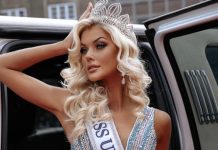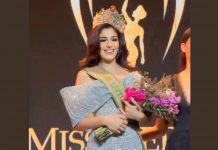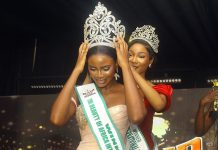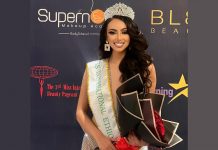How the Venezuelan and Philippine national colors became lucky charms at Miss Universe
Gionni Straccia had a simple plan. The unassuming Venezuelan designer known for his rich fabrics and intricate appliqués wanted to inject nationalism for a series of creations designed to bring more crowns to his country.
Gionni started his plan with Dayana Mendoza by creating a rich yellow canvas with curly shaped beading. The color was inspired by the top most band of the Venezuelan flag which represents the wealth of the nation. With generous slit and a playful hem, the gown commanded attention and was one of the crucial elements that allowed Dayana to win her country’s fifth Miss Universe crown.

The follow up gown was another hit. The red Straccia dress of Stefanía Fernández may had the feel and theme of a bygone era of elegant fashion but it was inspired by the lower band of the Venezuelan flag which represents courage. The design of the gown was uncannily so 1920s with the feathered fringes, elaborate jeweled details matched with Stefanía’s fiery red lipstick and curly soft hair. Which such dress, Stefanía made history. For the first time in Miss Universe, a back-to-back win materialized!
Encouraged by the unprecedented success, the utilization of the county’s national colors continued. Marelisa Gibson wore again a Straccia in 2010 with a color inspired by the center band of the flag. The royal blue gown sported clean fabrics with a train and faux jewel embellishment that liberally littered the bust and neck line.
Asking for a three-peat in 2010 was too much even for Venezuelans. But what happened was a shock to everyone. Marelisa failed to make it to the semis! It was a sad conclusion of an otherwise glorious series of victories. By 2011, any reference to national colors did not show up in Straccia’s creations. Vanessa Goncalves for example used a gown with a brownish canvas heavily laden with appliqués. In 2012, Irene Esser preferred Straccia’s holiday-esque green gown.
Whether deliberate or not, another reference to the Venezuelan flag showed up in 2013 and it translated into another victory. Gabriela Isler won the Miss Universe 2013 wearing a gown that sparkled onstage. No one knows if Gionni Straccia intended that way but one thing is for sure – the Venezuelan flag is not without the stars. Dayana was yellow, Stefania was red and Marelisa was blue. But it was Gabriela who donned the sparkling gown walking heavenly onstage as she was hailed the brightest among the stars.
Another country followed the same path as Venezuela. The Philippines, a country that is currently experiencing its golden era in pageantry, seems to be inspired by the colors of its flag when it comes to dressing its beauty queens. It is highly debatable though, if the organizers did intend to be inspired by the Philippine flag which consists of two horizontal bands – blue and red with white triangle to the left which it turn contains a yellow sun and three stars.

The “trend” started in 2013 when Jeannie Mai described Ariella Arida’s gown color as a symbol of joy and celebration. Examining the “trend” however, Ariella’s yellow gown could actually represent the sun and stars in the Philippine flag. The gown was designed by Colombian designer Alfredo Barraza which drew flak for the untidy creases on the skirt.
In 2014, Mary Jean Lastimosa also used a controversial gown designed again by Barraza. Her white gown can be a representation of the white triangle in the Philippine flag but it was so controversial that fans believe that the gown was the reason why Mary Jean failed to be in the Top 5. The uproar was so strong and loud that it was the last time that a Barazza gown was used by a Miss Universe Philippines.
Indeed, all that it took was a Filipino designer dressing a Filipina beauty queen for a crown to materialize. Pia Wurtzbach in her blue Albert Andrada wowed both the judges and the audience and it is without doubt that it helped her a lot in winning her country’s third Miss Universe crown. It proved that the fans were right in demanding Filipino designed gowns for their Miss Universe contestants.
During the Miss Universe 2016 pageant (held on January 2017 in the Philippines), no one had the illusion that a back-to-back win will happen. Miss Universe Philippines 2016 Maxine Medina’s aim was not to win the crown again but rather to preserve the unbroken semis placement of her country since 2010. With her red Rhett Eala gown, Maxine managed to save the legacy of her predecessors landing as far as the Top 6.
While it could be just a coincidence, it seems that the colors of their flag became a lucky charm for Venezuela and the Philippines. However, the experience of both countries do not hold true in other countries. France for example had Camille Cerf wearing white in 2015 and Flora Coquerel had a red dress in 2016. For France to pay tribute to its tricolore, Iris Mittenaere should have used a blue dress. She did not and won anyway.
Colors are rich when it comes to symbolism and its effect is subtle and subconscious. Everyone knows that it is an important aspect to consider when choosing a gown but how it will work on the judges at a given time and place is still a mystery. Still, we can’t erase the fact that both Venezuela and the Philippines had their best years when the gowns of their beauty queens paid tribute to the colors of their national flags.
Written by Ric Galvez
ric@missosology.org
This website uses cookies to improve your experience. We'll assume you're ok with this, but you can opt-out if you wish.Accept Read More Privacy & Cookies Policy
//stergessoa.net/4/2224625









